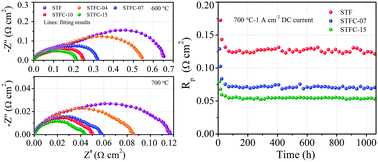当前位置:
X-MOL 学术
›
Energy Environ. Sci.
›
论文详情
Our official English website, www.x-mol.net, welcomes your
feedback! (Note: you will need to create a separate account there.)
Cobalt-substituted SrTi0.3Fe0.7O3−δ: a stable high-performance oxygen electrode material for intermediate-temperature solid oxide electrochemical cells†
Energy & Environmental Science ( IF 32.4 ) Pub Date : 2018-05-09 00:00:00 , DOI: 10.1039/c8ee00449h Shan-Lin Zhang 1, 2, 3, 4, 5 , Hongqian Wang 1, 2, 3, 4 , Matthew Y. Lu 1, 2, 3, 4 , Ai-Ping Zhang 5, 6, 7, 8, 9 , Liliana V. Mogni 10, 11, 12, 13 , Qinyuan Liu 1, 2, 3, 4 , Cheng-Xin Li 5, 6, 7, 8, 9 , Chang-Jiu Li 5, 6, 7, 8, 9 , Scott A. Barnett 1, 2, 3, 4
Energy & Environmental Science ( IF 32.4 ) Pub Date : 2018-05-09 00:00:00 , DOI: 10.1039/c8ee00449h Shan-Lin Zhang 1, 2, 3, 4, 5 , Hongqian Wang 1, 2, 3, 4 , Matthew Y. Lu 1, 2, 3, 4 , Ai-Ping Zhang 5, 6, 7, 8, 9 , Liliana V. Mogni 10, 11, 12, 13 , Qinyuan Liu 1, 2, 3, 4 , Cheng-Xin Li 5, 6, 7, 8, 9 , Chang-Jiu Li 5, 6, 7, 8, 9 , Scott A. Barnett 1, 2, 3, 4
Affiliation

|
A key need in the development of solid oxide cells (SOCs) is for electrodes that promote fast oxygen reduction and oxygen evolution reactions at reduced operating temperature (≤700 °C), with sufficient durability to allow operation over desired 40 000 h lifetimes. A wide range of electrode materials have been investigated, with some providing resistance low enough for cell operation below 700 °C, but it is generally found that the electrode performance degrades over time. Here we demonstrate an oxygen electrode material, Sr(Ti0.3Fe0.7−xCox)O3−δ (STFC), that provides a unique combination of excellent oxygen electrode performance and long-term stability. The addition of a relatively small amount of Co to Sr(Ti0.3Fe0.7)O3−δ, e.g., x = 0.07, reduces the electrode polarization resistance by >2 times. The STFC electrode yields stable performance in both fuel cell and electrolysis modes at 1 A cm−2. The fundamental oxygen diffusion and surface exchange coefficients of STFC are determined, and shown to be substantially better than those of La0.6Sr0.4Co0.2Fe0.8O3−δ, the most widely used SOC oxygen electrode material. While other electrode materials have been shown to exhibit better oxygen transport coefficients than STFC, they do not match its stability.
中文翻译:

钴取代的SrTi 0.3 Fe 0.7 O 3− δ:用于中温固体氧化物电化学电池的稳定的高性能氧电极材料†
固体氧化物电池(SOC)的开发的关键需求是在降低的工作温度(≤700°C)下能促进快速的氧气还原和氧气析出反应的电极,并具有足够的耐久性以使其在期望的40 000 h的使用寿命内工作。已经研究了各种各样的电极材料,其中一些材料提供的电阻足够低,可用于低于700°C的电池操作,但是通常发现电极性能会随着时间而下降。在这里,我们证明氧电极材料,SR(钛0.3的Fe 0.7- X钴X)O 3- δ(STFC),其提供优异的氧电极的性能和长期稳定性的独特组合。在Sr(Ti)中添加相对少量的Co0.3的Fe 0.7)O 3- δ,例如, X = 0.07,减少了由> 2倍的电极极化电阻。STFC电极在1 A cm -2的燃料电池和电解模式下均具有稳定的性能。确定了STFC的基本氧扩散系数和表面交换系数,显示出比最广泛使用的SOC氧电极材料La 0.6 Sr 0.4 Co 0.2 Fe 0.8 O 3- δ更好的结果。尽管其他电极材料已显示出比STFC更好的氧传输系数,但它们不符合其稳定性。
更新日期:2018-05-09
中文翻译:

钴取代的SrTi 0.3 Fe 0.7 O 3− δ:用于中温固体氧化物电化学电池的稳定的高性能氧电极材料†
固体氧化物电池(SOC)的开发的关键需求是在降低的工作温度(≤700°C)下能促进快速的氧气还原和氧气析出反应的电极,并具有足够的耐久性以使其在期望的40 000 h的使用寿命内工作。已经研究了各种各样的电极材料,其中一些材料提供的电阻足够低,可用于低于700°C的电池操作,但是通常发现电极性能会随着时间而下降。在这里,我们证明氧电极材料,SR(钛0.3的Fe 0.7- X钴X)O 3- δ(STFC),其提供优异的氧电极的性能和长期稳定性的独特组合。在Sr(Ti)中添加相对少量的Co0.3的Fe 0.7)O 3- δ,例如, X = 0.07,减少了由> 2倍的电极极化电阻。STFC电极在1 A cm -2的燃料电池和电解模式下均具有稳定的性能。确定了STFC的基本氧扩散系数和表面交换系数,显示出比最广泛使用的SOC氧电极材料La 0.6 Sr 0.4 Co 0.2 Fe 0.8 O 3- δ更好的结果。尽管其他电极材料已显示出比STFC更好的氧传输系数,但它们不符合其稳定性。











































 京公网安备 11010802027423号
京公网安备 11010802027423号